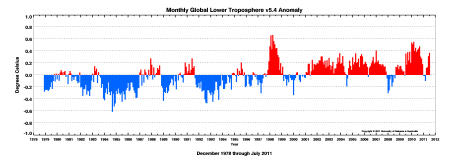UPDATE: I highly recommend this August 7 2011 post by Roy Spencer
Is Gore’s Missing Heat Really Hiding in the Deep Ocean?
where he uses observed and modeled ocean heat content changes as the evaluation criteria. I look forward to him adding other models and extending the data up to as close to the present as possible.
_____________________________________________________
On July 26 2011 I posted on a
Today, I want to comment on the science of this very much-needed, important paper
Spencer, R.W.; Braswell, W.D. On the Misdiagnosis of Surface Temperature Feedbacks from Variations in Earth’s Radiant Energy Balance. Remote Sens. 2011, 3, 1603-1613.
The abstract of this paper reads [highlight added]
“The sensitivity of the climate system to an imposed radiative imbalance remains the largest source of uncertainty in projections of future anthropogenic climate change. Here we present further evidence that this uncertainty from an observational perspective is largely due to the masking of the radiative feedback signal by internal radiative forcing, probably due to natural cloud variations. That these internal radiative forcings exist and likely corrupt feedback diagnosis is demonstrated with lag regression analysis of satellite and coupled climate model data, interpreted with a simple forcing-feedback model. While the satellite-based metrics for the period 2000–2010 depart substantially in the direction of lower climate sensitivity from those similarly computed from coupled climate models, we find that, with traditional methods, it is not possible to accurately quantify this discrepancy in terms of the feedbacks which determine climate sensitivity. It is concluded that atmospheric feedback diagnosis of the climate system remains an unsolved problem, due primarily to the inability to distinguish between radiative forcing and radiative feedback in satellite radiative budget observations.”
The figure from their abstract is reproduced below.
“We have shown clear evidence from the CERES instrument that global temperature variations during 2000–2010 were largely radiatively forced. Lag regression analysis supports the interpretation that net radiative gain (loss) precedes, and radiative loss (gain) follows temperature maxima (minima). This behavior is also seen in the IPCC AR4 climate models.”“…..we are…… faced with a rather large discrepancy in the time-lagged regression coefficients between the radiative signatures displayed by the real climate system in satellite data versus the climate models. While this discrepancy is nominally in the direction of lower climate sensitivity of the real climate system, there are a variety of parameters other than feedback affecting the lag regression statistics which make accurate feedback diagnosis difficult.”
“….much of the temperature variability during 2000–2010 was due to ENSO…, we conclude that ENSO-related temperature variations are partly radiatively forced. We hypothesize that changes in the coupled ocean-atmosphere circulation during the El Niño and La Niña phases of ENSO cause differing changes in cloud cover, which then modulate the radiative balance of the climate system. As seen in Figure 3(b) for the ocean-only data, the signature of radiative forcing is stronger over the oceans than in the global average, suggesting a primarily oceanic origin.”
My Comments:
First, their paper is a major, constructive addition to the discussion of climate forcings and the climate response. A major strength of their study is that is based on real-world observations!
I disagree, however, with the authors on their statement that
“The sensitivity of the climate system to an imposed radiative imbalance remains the largest source of uncertainty in projections of future anthropogenic climate change.”
The identification of what are the human and natural climate forcings and feedbacks are, in my view, a larger source of uncertainty. The Spencer and Braswell paper perpetuates the inappropriately narrow view that the response of the global average surface temperature to an imposed radiative forcing is the largest source of uncertainty. Unfortunately, while I agree that this is an important issue, it only a subset of the important climate issues, as documented, for example, in
National Research Council, 2005: Radiative forcing of climate change: Expanding the concept and addressing uncertainties. Committee on Radiative Forcing Effects on Climate Change, Climate Research Committee, Board on Atmospheric Sciences and Climate, Division on Earth and Life Studies, The National Academies Press, Washington, D.C., 208 pp.
It is also important to realize that this study is with respect to a relatively short time period (2000-2010). It does not directly show that climate models are in error on longer time periods.
Nonetheless, the Spencer and Braswell is a very major contribution to the climate science debate. If, as they have shown, the models are unable to properly represent how the climate system responds to radiative imbalances on short time periods, it certainly raises serious questions on the robustness of the models in terms of their modelled physics which necessarily would result in flawed model simulations on multi-decadal time scales.


